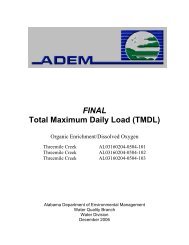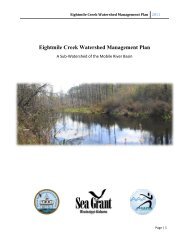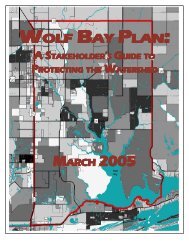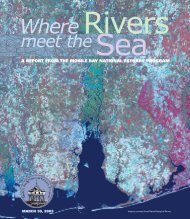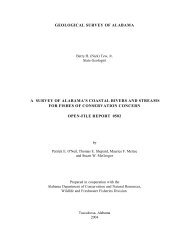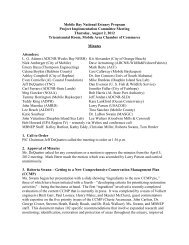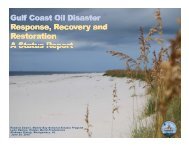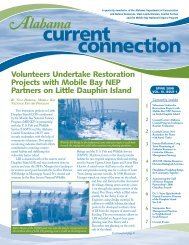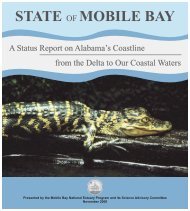Conserving Alabama's Coastal Habitats - Mobile Bay National ...
Conserving Alabama's Coastal Habitats - Mobile Bay National ...
Conserving Alabama's Coastal Habitats - Mobile Bay National ...
- No tags were found...
Create successful ePaper yourself
Turn your PDF publications into a flip-book with our unique Google optimized e-Paper software.
MethodologyThrough a series of workshops held by MBNEP and TNC, area conservation organizations and researchersworked to define conservation targets – the species, systems or natural communities that needed to be protectedacross landscapes. During the first planning workshop, held in December 2003, the group brainstormed a list ofall possible targets, consolidated them into major groupings, identified species that did not fit into groupings andidentified species or communities that required special management or conservation attention. This list wasnarrowed to 8 targets for each conservation area that best reflected the eco-regional conservation goals, representedthe biodiversity of the site, and which were highly threatened.This workshop was followed by a series of one day working sessions held in January 2004 to identify andprioritize threats facing the conservation targets in each area. In the Conservation by Design process, threats aredetermined first by developing a list of stresses. These are the altered ecological indicators that suggest that aconservation target is stressed (i.e. declining population size, altered fire regime, or altered structure/composition).Then, the sources of those alterations are identified (i.e. incompatible recreation, invasive species colonization,or a specific activity like dredging). These stresses and sources of stress combine to form a picture of the threatsfacing our conservation targets. For the four areas, each of these threats was ranked, based on their severity, scope,and likelihood of success for action to provide a sense of the highly ranked threats that needed immediateconservation action.In March 2004, a workshop was held to brainstorm strategies by which highly ranked threats to the conservationtargets could be abated. Such strategies can be roughly divided into two categories – threat abatement strategieswhich protect targets or restoration strategies that improve their viability. This workshop was followed in May2004 by the first meeting of the MBNEP’s <strong>Coastal</strong> Habitat Coordinating Team. This meeting was intended tobring together conservation organizations to brainstorm and priority sites for habitat acquisition and restoration incoastal Alabama, and to identify partnerships for achieving protection of these sites, based on the comprehensivelist generated by the previous workshops.Throughout this meeting the following objectives were considered when prioritizing tracts foracquisition and restoration:• Maintain and/or improve beneficial wetland function within the <strong>Mobile</strong> <strong>Bay</strong>watershed by reducing loss in quality and quantity or restoring degradedmarsh habitats and increase acreage by 5%• Reduce the loss of beach and dune habitat• Reduce the loss of bay/sound/bayou intertidal habitat due to bulkheading• Prevent the loss of nesting habitat for colonial and migratory birds dueto human disturbance and alteration• Restore or protect Submerged aquatic vegetation habitat and increaseacreage by 3% from 2001 levelsAlso considered when selecting priority sites were the habitat goals of the EPA Gulf of Mexico Programwhich are to:• Restore, enhance, or protect important coastal and marine habitats thatare essential to the recreational and commercial fisheries of the Gulf,including the prevention and control of invasive species by 20,000 acres by 2009, and• Restore, protect or enhance 2400 acres of coastal and marine habitat eachyear between 2002 and 2009.6



